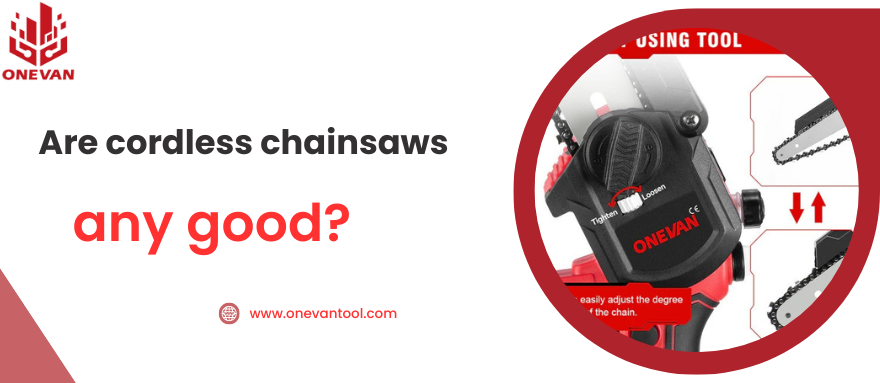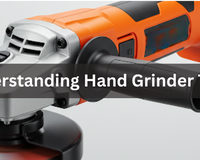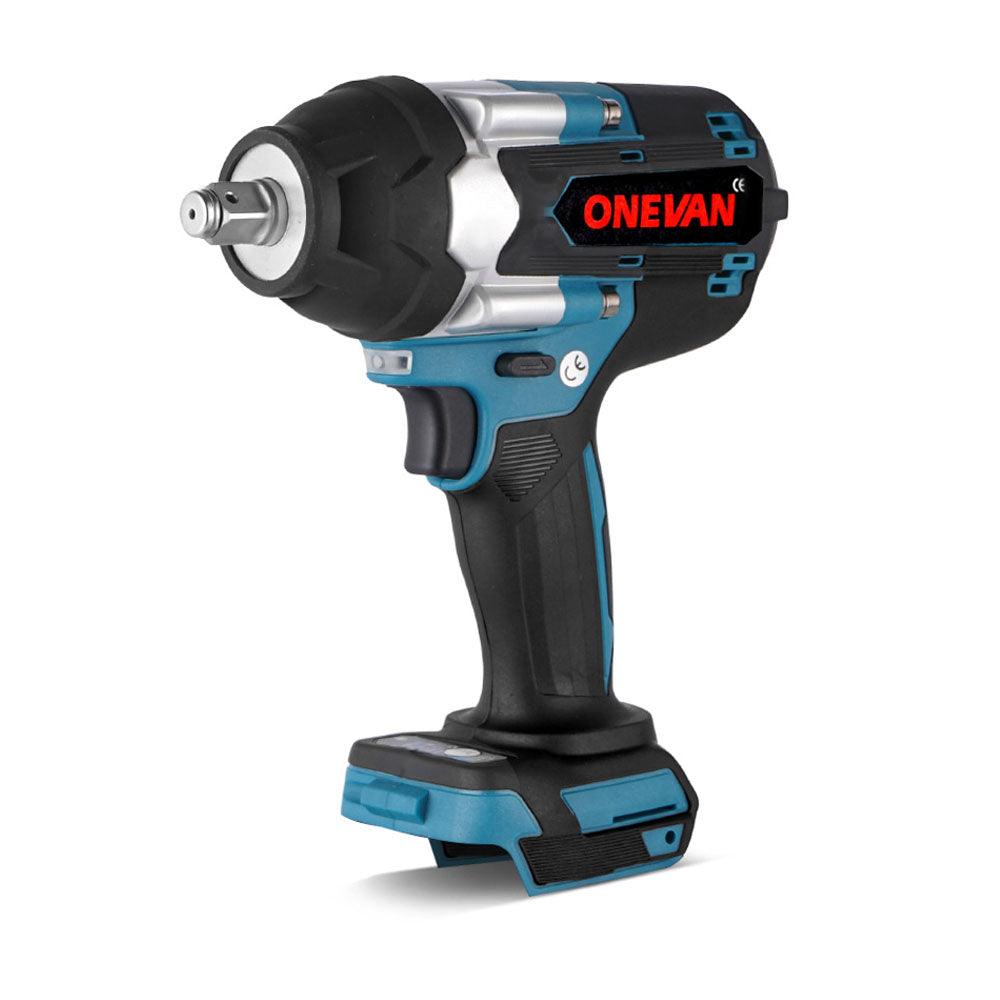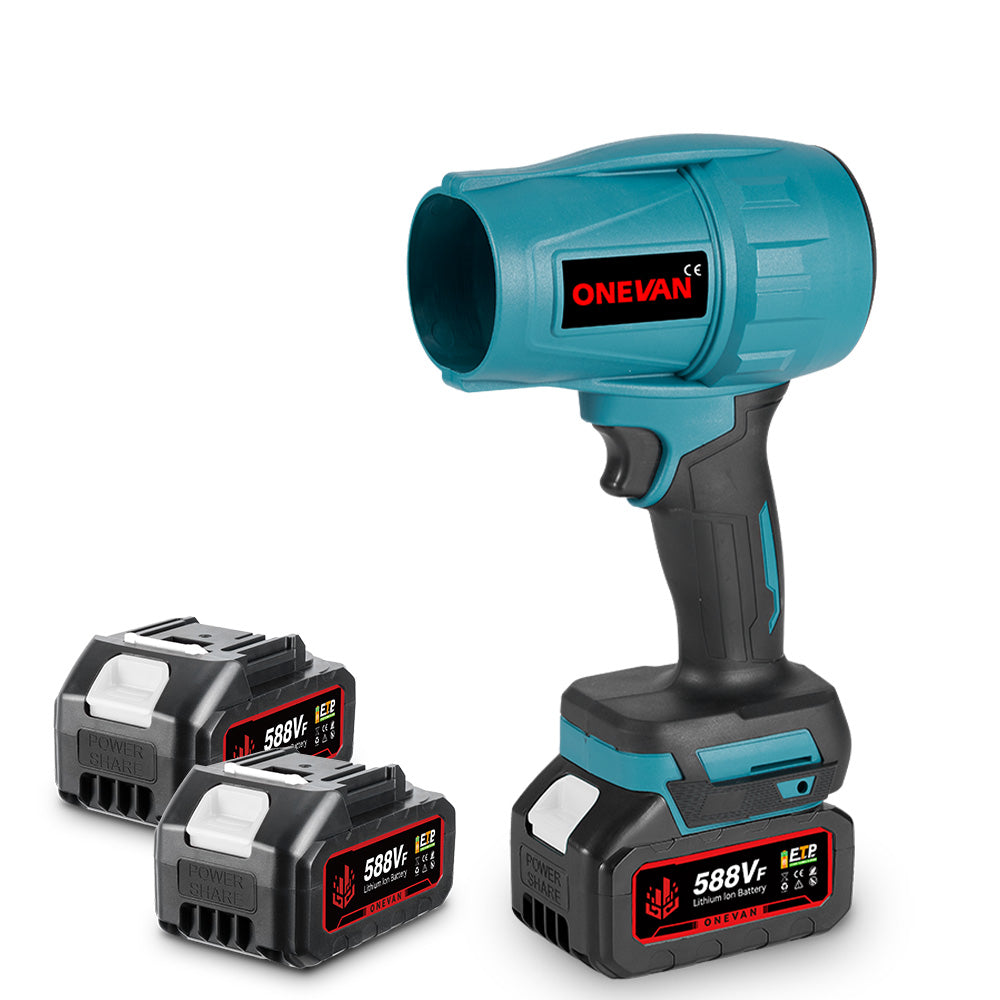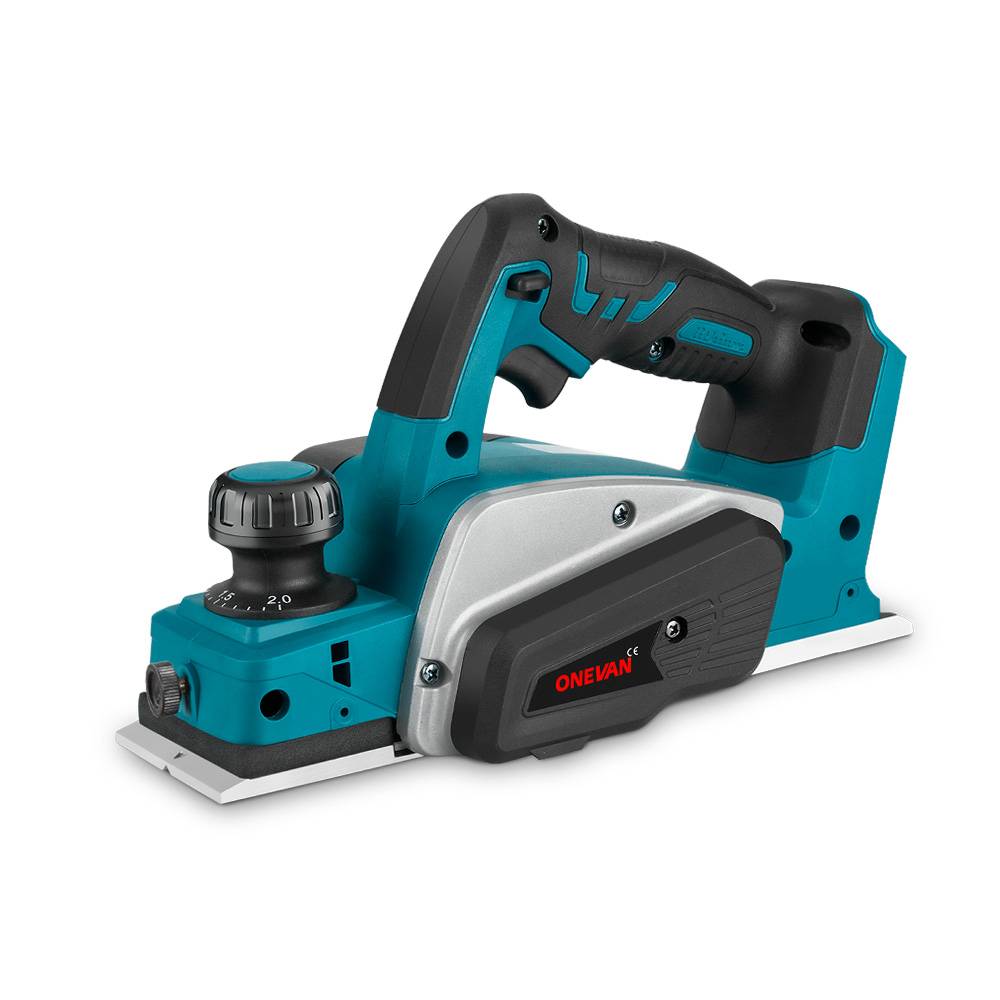Chainsaws have been a must-have tool for cutting down trees and tackling difficult cuts since the 1900s. At that time, several people were needed to handle them because they were tackling bulky electric motors. It wasn’t until 1927 that chainsaws equipped with gasoline engines became widely available, transforming them into the powerful one-man tools we know today.
Lithium-ion batteries operated chainsaws are a suitable option for many homeowners. They are eco-friendly and quieter. They're perfect for:
- Trimming branches, cutting firewood, or clearing brush.
- Tackle difficult tasks easily.
- Cordless chainsaws are significantly quieter, making them ideal for residential areas
Chainsaws have a rich history of development. Here's a precise timeline of their evolution:
1780s: Early "osteotomes," essentially chainsaws for surgery (thankfully short-lived!), are developed. They soon find a more appropriate use: felling trees.
1853: Franz Xaver Prefsler of Austria receives a patent for a steam-powered chainsaw. It wasn't practical for widespread use.
1885: J. Beverly Robson of England patents a chainsaw design closer to what we recognize today. It still lacked the required power.
1926: A turning point! Andreas Stihl invents the first commercially viable chainsaw, a heavy electric model. This marked the beginning of the chainsaw revolution.
1927: Emil Lerp introduces the world's first commercially successful gasoline-powered chainsaw, which significantly improves the portability and power of these tools. While offering more freedom than electric models, it still required two people to operate.
1950s: This innovation made chainsaws portable and powerful tools for forestry and woodworking.
Early 2000s: Lithium-ion batteries accelerated performance of new generation of power tools.
Present Day: Cordless chainsaws are being manufactured by different manufacturers on a large scale carrying unique features.
1. What Are the Benefits of Cordless Chainsaws?

Cordless chainsaws are famous for two reasons:
- They are practical and user-friendly
- A good alternative to gas-powered chainsaws
Read some practical benefits in detail below:
Significantly Convenient
Battery-operated chainsaws eliminate the need for long extension cords and power outlets. They are ideal for:
- Trimming branches in tight spaces.
- Clearing brush in remote areas. (can be used for both domestic and commercial purposes)
- Enables quick cuts without a power source.
According to a 2023 survey by the National Home Improvement Association, 62% of homeowners expressed a preference for outdoor power tools, a need that cordless chainsaws are well-equipped to meet.
User-friendly Design
Cordless chainsaws are significantly lighter. For instance:
- Reduced fatigue during extended use.
- User-friendly handling with better control and precision.
- Work comfortably in overhead and awkward positions due to the lighter weight of cordless chainsaws."
On average, cordless chainsaws weigh around 40% less than gas-powered models. This can make a big difference in executing time-consuming tasks.
Low Maintenance
Gas-powered chainsaws need consistent maintenance such as spark plug replacement, oil mixing, and air filter cleaning. Cordless models provide the following advantages:
- No complicated engine tune-ups.
- Only recharge the battery and start working.
- Minimum wear and tear.
A study by the American Society of Homeowners shows 72% of homeowners' first choice is a power tool.
Eco-Friendly
Cordless chainsaws produce zero emissions. On the other hand, gas-powered chainsaws leave carbon footprint significantly. Therefore, battery chainsaws are a good choice for:
- Discouraging carbon footprint.
- Working in noise-sensitive areas.
- Can be used indoors with proper ventilation.
Safety Features
Many cordless chainsaws have safety features that ensure safety during work:
- Electric brakes that stop the chain quickly.
- Handguards to protect your hands from accidental contact with the chain.
- Kickback protection reduces the risk of the chainsaw's blade being forcefully thrown back towards the operator.
These features give a smooth and flawless operating experience to its users.
Improved Battery Technology
Cordless Battery technology has shown significant improvements in recent years. These are:
- Improved run times on a single charge, typically ranging from 30 to 60 minutes depending on the model and usage.
- Faster charging time.
- More durable batteries.
2. Applications of Cordless Chainsaws
Imagine this: you're out in your garden, trying to remove an unwanted branch. No need to invest in expensive and heavy gas chainsaws which can make you lethargic. Cordless chainsaws can be used for range of applications which you will read below.
Using Cordless Chainsaws for Routine Garden Pruning:
Preparation:
- Ensure safety: Wear gloves, safety glasses, long pants, and shoes.
- Clear the Area: Remove any obstacles, bystanders, or pets.
- Plan Your Cuts: Locate the branches to prune. Consider the branch's weight and how it will fall after cutting. It is important to avoid any damage.
Making the Cut:
- Positioning: Stand with a firm footing, slightly back from the cutting area. Keep the chainsaw cord away from the blade.
- Undercut: For thicker branches (over 2 inches), start with an undercut 1/3 from the underside. This prevents the branch from pinching the chainsaw.
- Top Cut: Top cut all the way through the branch, a few inches above the undercut. This will prevent the branch from tearing.
- Small Branches: For thinner branches (under 2 inches), a single cut is sufficient.
Remember:
- Cut with the Tip
- Avoid pushing the chainsaw too hard; let the tool do the work.
- Cut in sections to manage the workload and maintain control over the chainsaw.
- Take Breaks
For Garden Pruning Consider ONEVAN 8" Brushless Outdoor Pruning Saw
It comes with some stunning features like:
|
Feature |
Description |
|
Lubrication |
Automatic spray lubricating oil design |
|
Chain |
High quality alloy chain, wear-resistant, durable |
|
Applications |
Forest cutting, wood cutting, pruning branches |
|
Motor |
Powerful copper motor, strong power, stable output |
|
Motor Type |
Brushless motor |
|
Speed |
45000 rpm |
|
Cutting Diameter |
30cm (approx. 11.8 inches) |
|
Bar Length |
8 inches |
|
Chain Speed |
10m/s (approx. 22.4 mph) |
|
Oil Discharge |
Press to dispense oil |
|
Display |
Digital display for power level |
|
Portability |
Soft rubber handle, anti-skid, sweat-absorbing |
|
Safety |
Widen baffle design to prevent wood chip splash |
|
Cooling |
Heat dissipation hole design for efficient ventilation |
Efficient Tree Felling with Cordless Chainsaws
Tree Felling Procedure:
- Planning the Fall: Don’t start cutting until you check the tree's condition. Mark a clear escape path at a safe distance.
- Undercut Technique: Switch on cordless chainsaw, begin the felling process with an undercut on the side towards which the tree will fall.
- Back Cut: On the opposite side of the undercut, create a horizontal back cut a few inches higher than the base of the undercut. It will help the tree's fall in the pre-marked area.
- Fall Control and Limbing: When you notice back cut is near to completion, insert wedges to control the fall direction. Always remember that stand behind the falling tree. After the tree has fallen safely, use the cordless chainsaw to remove limbs.
Use of Cordless Chainsaw in Forestry
Planning and Preparation:
• Choose the Right Tool: Choose a cordless chainsaw with an effective power that will be suitable for the size of the tree. Don’t forget to carry battery backup.
• Pack Smart:Carry extra batteries, a solar panel/generator (for long trips), a basic toolkit, and spare parts like chains.
• Safety First: Ensure that you wear suitable PPEs; this includes gloves, boots and goggles as mentioned above.
Operational Techniques:
Proper felling guidelines include the undercut, the back cut, controlling the fall, and limbing; cordless chainsaw do the best with small trees.
Cordless Chainsaws for DIY Home Renovation Projects
A battery-operated chainsaw can be used in a range of do it yourself projects effectively.
Demolition Projects: Breaking down old wooden structures like sheds, decks, or fences is a breeze with a cordless chainsaw. Its lighter weight allows for better control compared to bulkier gas-powered models, minimizing accidental cuts to surrounding areas.
Tree Trimming and Branch Removal: Specifically for smaller trees or overgrown branches near your house, a cordless chainsaw provides excellent control for precise cuts. This is crucial to avoid damaging power lines, gutters, or siding on your home.
Cutting Lumber: Need to cut dimensional lumber for a project but lack a stationary saw? A cordless chainsaw can handle smaller cuts to wood beams, planks, or even firewood preparation.
How to Use Cordless Chainsaws in DIY Projects?
Plan Your Cuts: Before starting, visualize the final outcome and plan your cutting strategy. Consider the size and weight of objects you'll be cutting and ensure a clear path for them to fall.
Secure Your Work Area: Clear the area of debris, bystanders, and pets. Make sure nothing flammable is nearby when using the chainsaw.
Cutting Techniques: Use a sawing motion with the tip of the chainsaw bar for cleaner cuts and better control. Avoid using excessive force.
Cutting Large Pieces: For bigger projects like demolition, cut large pieces into manageable parts to avoid any accident.
Cordless Chainsaws in Crafting and Sculpture
Safety rules
- Use Personal Protective Equipment (PPE) is Mandatory
- Never operate a chainsaw without proper training
- Plan your cuts carefully
- Maintain a clear path for falling pieces
- Always avoid cutting above shoulder height to maintain control and prevent injury from kickback or loss of balance.
- Keep the chainsaw cord away from the blade at all times.
- Don't force the saw
- Take breaks
For Wood Sculpting:
- Start with rough cuts to remove large wood.
- Controlling the tip of the chainsaw bar will give you detailed carving.
- When the shape is near to ready, give finer cuts with slow movements.
- For developing complex details, use chisels, gouges, and rasps
Wilderness Preparedness with a Cordless Chainsaw
Bucking and Limbing Techniques:
- Bucking (Cutting Logs into Usable Lengths):
- Use a cradle technique for supported cuts.
- Employ the "bore cut" for larger logs. Make a horizontal cut about 1/3 of the way through the log from both sides.
- Limbing (Removing Branches from Fallen Trees):
- Use a sawing motion with the tip of the bar.
- Watch for "kickback" (sudden upward movement of the chainsaw).
Felling Techniques (For Experienced Users Only):
- Use a horizontal bore cut on the hinge side.
- Strategically insert wedges into the back cut to control the direction of the fall.
Important Safety Rules:
- Never attempt these techniques without proper training and experience. Always prioritize safety and consult a professional for complex tasks.
- Always prioritize safety
- For larger projects or complex felling situations, consult a professional.
Custom Furniture with Cordless Chainsaws
Planning and Design:
- Start by brainstorming. Sketch out your design, including dimensions and desired features..
- Choose suitable wood. Consider factors like strength, weight, and grain pattern. Dry & seasoned wood is good for easier cutting.
- Following your design, make a detailed cutting list such as dimensions and number of wood pieces required.
- Safety First: Before starting any work, ensure you have the proper Personal Protective Equipment (PPE), including gloves, safety glasses with a face shield, and ear protection.
Cutting with the Cordless Chainsaw:
- Choose a well-ventilated and clear workspace..
- Ensure you have a sharp chainsaw blade for clean cuts.
- Begin by making rough cuts to remove large sections of wood. Don't force the saw – let it do the work.
- As soon as you have the basic shapes, use a controlled sawing motion to achieve precision, following your design dimensions.
- To get curved cuts, use short, controlled strokes with the tip of the bar.
Assembly and Finishing:
- Create joints (like mortise and tenon). This involves using hand tools or power tools like a drill and router.
- After assembly, use sandpaper of varying grits.
- For finishing, apply a wood stain, paint, or sealant to protect your furniture.
Cutting Firewood with a Cordless Chainsaw
- Safety First
- Gloves: Thick leather or synthetic
- Safety Glasses with Face Shield
- Boots for ankle support
- Long Pants
- Ear Protection
- Chainsaw is Ready:
- Have a spare battery on hand for extended work.
- Proper Tension and Lube.
- Regularly sharpen your chainsaw blade for smooth cutting.
- Source Your Wood:
- Dry wood splits easier, and burns better. Avoid green or wet wood.
- Select logs that are appropriate for your chainsaw's bar length. Aim for logs that are 8-12 inches in diameter.
Expert Cutting Techniques:
- Felling (Large Logs):
- Undercut: Make a 45-degree angled cut about 1/3 of the way through the trunk on the felling side.
- Back Cut: Make a horizontal cut a few inches above the bottom of the undercut on the opposite side.
- Control the Fall: Use wedges (if necessary) to control the direction of the fall.
- Limbing and Bucking:
- Use a sawing motion with the tip of the chainsaw's guide bar to remove branches efficiently.
- Cut the logs into firewood-sized pieces using a sawing motion. Aim for straight cuts (16-20 inches is a good standard firewood length).
3. Cordless vs. Corded Chainsaws
|
Feature |
Cordless Chainsaw |
Corded Chainsaw |
|
Power Source |
Battery |
Electric Cord |
|
Mobility |
Highly portable, can be used anywhere |
Limited by cord length, needs access to outlet |
|
Noise Level |
Generally quieter |
Louder due to electric motor |
|
Maintenance |
Less maintenance (mainly chain sharpening) |
Requires occasional brush cleaning and maintenance |
|
Starting |
Easy push-button start |
Requires cord pull to start |
|
Emissions |
Zero emissions |
No direct emissions, but electricity generation might |
|
Power |
Lower power, suitable for smaller trees and branches |
Higher power, suitable for larger trees and thicker cuts |
|
Run Time |
Limited by battery life (typically 30-60 minutes) |
Continuous operation as long as plugged in |
|
Cost |
Generally more expensive |
Generally less expensive |
4. Cordless vs. Gas-Powered Chainsaws
|
Feature |
Cordless Chainsaw |
Gas-Powered Chainsaw |
|
Power Source |
Battery |
Gasoline |
|
Fueling |
Rechargeable battery |
Gas/oil mix |
|
Power Output |
Lower (generally equivalent to 20-50cc gas saws) |
Higher (ranges from 30cc to 80cc+) |
|
Bar Length |
Shorter (typically 10-18 inches) |
Longer (typically 14-24 inches, some up to 36 inches) |
|
Displacement |
N/A |
25cc - 80cc+ |
|
Starting |
Push-button |
Pull cord |
|
Noise Level |
Quieter (around 90-100 decibels) |
Louder (around 100-105 decibels) |
|
Emissions |
Zero |
High |
|
Maintenance |
Less maintenance (chain sharpening) |
More maintenance (oil changes, spark plug cleaning, filter cleaning) |
|
Run Time |
Limited by battery life (typically 30-60 minutes per charge) |
Continuous operation with refueling |
|
Portability |
Easier to maneuver due to lighter weight and no cord |
More powerful models can be heavy |
|
Cost (Initial) |
Generally more expensive upfront |
Generally less expensive upfront |
|
Cost (Long-Term) |
Lower running costs (no gas/oil) |
Higher running costs (gas/oil) |
|
Ideal Uses |
Trimming branches, cutting firewood (smaller diameter logs) |
Heavy-duty tasks like felling trees, bucking large logs & land clearing |
5. Cordless Chainsaw User Reviews
1. Mark (Hobbyist):
"I just love my cordless chainsaw for trimming and cutting firewood for my fireplace. It's so convenient to start than my old gas-powered model. The battery life lasts long enough for most of my trimming jobs, and it recharges pretty quickly. However, for bigger jobs like bucking large logs, I still use the gas chainsaw. Overall, the cordless chainsaw is a great addition to my tool shed for smaller tasks."
2. Sarah (Professional Landscaper):
"My high-end cordless chainsaw is good for many jobs. It's fantastic for limb removal and smaller tree takedowns. The weight difference is a huge benefit, especially on long days. Battery life has improved significantly, and I usually carry a spare for extended work. It's also a lifesaver for noise-sensitive client properties."
3. David (Arborist):
"For climbing and working in tight spaces, a lightweight cordless chainsaw is invaluable. The ability to maneuver easily and make precise cuts is crucial for proper tree care. While I wouldn't use it for major branch removal, it's perfect for deadwooding and targeted pruning. However, durability is a concern for professional use. I've gone through a couple of models due to demanding work conditions."
4. Jane (Firewood Enthusiast):
"I use my cordless chainsaw for processing smaller firewood and cutting up branches for kindling. It's quiet enough to use early mornings without bothering the neighbors. The battery life lasts for a decent amount of processing, but I wouldn't recommend it for full-day firewood cutting sessions. It's a great option for casual use and keeping up with firewood needs for a small fireplace."
5. The Gear Guru (YouTube Channel):
"In my recent review of the Stihl MSA 220, I was impressed by its power and cutting speed. It tackled most tasks a homeowner would encounter with ease. Battery life was decent, lasting around 45 minutes of moderate cutting. However, the price tag is on the higher end. For budget-conscious users, there are good cordless options available, but expect less power and shorter run times."
6. Conclusion
In conclusion, cordless chainsaws are convenient to use. There require lower-maintenance which is a good option for homeowners. However, battery life and power limitations can restrict their use for larger jobs. Professional users prefer choosing battery operated chainsaws with extended battery life under load, robust build quality, and readily available parts.7. FAQ
1. Are cordless chain saws beneficial?
Battery-operated chainsaws are perfect for various applications. For example, it is good for the homeowners who need a power tool to groom:
- Backyard plants
- Shrubs
- Plant maintenance
- As well as cutting firewood.
2. What are the advantages of a battery chainsaw?
Convenience: No messing with gas and oil, easy push-button start.
Quiet operation: More pleasant to use and neighbor-friendly.
Lower maintenance: Just needs chain sharpening, no engine maintenance hassles.
Lighter weight: Easier to maneuver for limb trimming and smaller cutting jobs.
Reduced emissions: Eco-friendly choice.
3. What is an average battery life of battery chainsaw?
The battery life of an electric chainsaw depends on multiple factors, such as the model, battery size, and usage.
Generally, you have 30-60 minutes of cutting time with a single charge. Some high-end models come with longer run time. The life of the chainsaw can be long or short depending with how it is used and maintained.
4. What points to consider when buying a cordless chainsaw?
Power: Think about the kind of cutting operations. Tougher jobs need higher power models although they are more expensive than the regular models.
Bar length: Select a bar length depending on the size of the wood.
Battery life: On an average, for how many hours does one have to use a chainsaw for a particular job? It is recommended to get an extra battery to increase usage time.
Brand reputation: Search for the products from the companies that have good reputation and offer quality products with after sales services.
5. How large of a cordless chainsaw should I get?
The size of the chainsaw depends on the length of the bar. The recommended length for a bar is short (10-14 inches) for cutting branches and small trees. The longer bar which ranges from 16 to 18 inches is preferable when it comes to cutting firewood and even larger diameters.
6. Can we use battery chainsaw in cutting trees?
Yes, you can incorporate cordless chainsaws for cutting trees. However, bigger trees require specific chainsaws with higher power capacity. Nonetheless, the cordless chainsaws are useful in cutting down small trees and branches.
7. Are battery powered chainsaws safe than gasoline chainsaws?
Some aspects make cordless chainsaws a wise option. This reduces the chances of kickback as there is no pull cord to yank. Also, the electric motor is less noisy. It is recommended to wear a pair of gloves, eye protection, and long pants.
8. Can we use a battery operated chainsaw in the rain?
Cordless chainsaws should not be used in the rain due to the risk of short-circuiting the electrical components, which can be dangerous. Always ensure your chainsaw is used in dry conditions to prevent electrical hazards.
9. Do battery-powered chainsaws need chain oil?
Yes, all chainsaws be it electric or gasoline need regular chain lubrication. This minimizes wear and tear and heat development which in turn increases chain and bar life.
10. How to maintain battery operated chainsaw?
Cordless chainsaw is easy to maintain since it does not have any cord. Here are some key points:
- Always make sure that the chain is sharp.
- It is recommended to clean the bar and chain after every use.
- Check the tension of the chain and correct it if necessary.
- Rinse the chainsaw with water and sponge to get rid of dirt and debris.
- Check the user manual to know which maintenance is necessary.
- Put the battery in a cool and dry place

